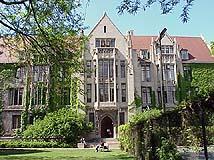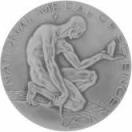 The website is in construction. New files will be uploaded as soon as they are available.
The website is in construction. New files will be uploaded as soon as they are available.
MARSHALL HARVEY STONE
New York, New York 1903 - Madras, India 1989

- Brief scientific biography
- Contributions to Education
- Relevant bibliography
- Publications on the teaching of mathematics
Brief scientific biography

Harvard Yard, 1920
Marshall Harvey Stone was born on 8 April 1903 in New York City and attended public schools in Englewood, New Jersey. He was the son of Harlan Fiske Stone, who was professor and dean at the Columbia University Law School and later the Chief Justice of the United States (1941-1946). Stone's family expected him to become a lawyer like his father, but he developed an interest in mathematics while an undergraduate at Harvard University, receiving his A.B. when he was 18. He completed a Harvard Ph.D. in 1926, with a thesis on differential equations supervised by George Birkhoff. Between 1925 and 1937, he taught at Harvard, Yale, and Columbia. He was promoted to full professor at Harvard in 1937.

Eckert Hall,University of Chicago
The department that Stone joined in 1946 was in the doldrums, after having been at the turn of the 20th century arguably the best American mathematics department, thanks to the leadership of Eliakim Hastings Moore. Stone did an outstanding job of making the Chicago department eminent again, mainly by hiring Paul Halmos, André Weil, Saunders Mac Lane, Antoni Zygmund, and Shiing-Shen Chern. The years of Stone's chairmanship became known as "the Stone Age" at Chicago.
Stone did much of his important work in mathematics during the 1930s, including his 1930 proof of the celebrated Stone-von Neumann uniqueness theorem, his definitive 1932 monograph on linear transformations in Hilbert space, his work in 1934 on what is now called Stone-Cech compactification theory, and his 1937 proof of the famous Stone-Weierstrass theorem.
After Stone retired from Chicago, he accepted the newly created George David Birkhoff Professorship of Mathematics at the University of Massachusetts in Amherst. He occupied that position full time until 1973 and half time thereafter until his second retirement in 1980. He was an avid traveler who served as a visiting professor at many universities around the world. He died suddenly on 9 January 1989 in Madras, India, where he had gone to attend a music festival. He was survived by his second wife, three children, one stepchild, six grandchildren, and two great-grandchildren.

From 1948 to 1950, Stone directed the world-wide work that led to the reestablishment of the International Mathematical Union after the Second World War. He served on the Interim Executive Committee of the new IMU from 1950 to 1952 and was its first president from 1952 to 1954. In that capacity, he was an ex officio member of the Executive Committee of the International Commission on Mathematical Instruction. He then served as ICMI vice-president from 1955 to 1958 and ICMI president from 1959 to 1962.
Contributions to education

In the United States, Stone was an articulate, unabashed advocate of reforming school and college curricula to include modern mathematics (DEMOTT, 1962, ZITARELLI, 2001). In a 1961 article addressed to U.S. college teachers, he sketched the revolutionary developments in mathematics during the 20th century and argued that the teaching of mathematics needed to be modernized accordingly:
"The college can hardly undertake a richer and more advanced program in mathematics unless it is willing to eliminate a considerable amount of deadwood from the traditional college curriculum. There are a good many obvious candidates for elimination, subjects which should either be taught in high school or not be taught at all. Let us cite college algebra, solid geometry, most of numerical trigonometry, descriptive geometry, and some topics in the calculus. Since a great many-perhaps a majority-of our colleges are still teaching these subjects, the work of reform has to begin by banishing them from the college curriculum. Only when this has been accomplished can the college mathematics program be given its proper scope and brought to the proper level of quality". (p. 732)Reviewing the Cambridge Conference Report Goals for School Mathematics, seen by many as radical, Stone (1965) was disappointed that the conferees had been so timid in setting curricular goals:
"I am in no doubt whatsoever that the Report by implication rejects many of the bolder, more imaginative, and more profound modifications of the school mathematics curriculum that are beginning to win acceptance in Europe, both in the west and in the east". (p. 353)He saw the report not as daring, comprehensive, or progressive, but rather as superficial, confused, and full of wishful thinking:
"It is superficial in its treatment of the content and organization of the mathematics curriculum; confused in the presence of the very deep reasons for a new, modern approach to algebra and geometry at the school level; and willful in its refusal to face up to the pedagogical difficulties involved in the sweeping changes it proposes". (p. 354)Stone ended his critique by pointing to the "outmoded and inadequate preparation we are still giving to our future mathematics teachers" (p. 360) as the real obstacle to reforming school mathematics.
Relevant bibliography
M.H. STONE 1932, Linear transformations in Hilbert space and their applications to analysis, American Mathematical Society Colloquium Publications, 15, Providence, RI, American Mathematical Society
M.H. STONE 1936, The theory of representations for Boolean algebras, Transactions of the American Mathematical Society, 40, 37-111
M.H. STONE 1937, Applications of the theory of Boolean rings to general topology, Transactions of the American Mathematical Society, 41, 375-481
M.H. STONE 1967, Mathematics and the future of science, Bulletin of the American Mathematical Society, 63, 61-76
M.H. STONE 1976, A reminiscence on the extension of the Weierstrass approximation theorem, Historia Mathematica, 3, 328
F.E. BROWDER 1989, The Stone Age of mathematics on the Midway, Mathematical Intelligencer, 11, 3, 20-25
B. DE MOTT 1962 (Spring), The math wars, American Scholar, 296-310, reprinted in R.W. Heath (edited by) 1964, New curricula, New York, Harper & Row, 54-67
G. KOLATA 1989 (January 11), M.H. Stone, acclaimed mathematician, dies at 85, The New York Times, B10
G.W. MACKEY 1989, Marshall Harvey Stone, Notices of the American Mathematical Society, 36, 221-223
J.J. O'CONNOR, E.F. ROBERTSON 2005, Marshall Harvey Stone, retrieved from the MacTutor History of Mathematics Archive web site:
http://www-gap.dcs.st-and.ac.uk/~history/Biographies/Stone.html
D.E. ZITARELLI 2001, Towering figures in American mathematics, 1890-1950, American Mathematical Monthly, 108, 606-635
J.D. ZUND 1999, Stone, Marshall Harvey, American National Biography, 20, 864-865, retrieved from the American National Biography web site:
http://www.anb.org/articles/13/13-02509.html
Publications on the teaching of mathematics
M.H. STONE 1961, The revolution in mathematics, American Mathematical Monthly, 68, 715-734
M.H. STONE 1964 (July-December), Reflections on the teaching of mechanics, Mathematics Student (Indian Mathematical Society), 32, nos. 3 and 4
M.H. STONE 1965, Review of Goals for school mathematics: The report of the Cambridge Conference on School Mathematics, Mathematics Teacher, 58, 353-360
Author
Jeremy Kilpatrick
University of Georgia
jkilpat@uga.edu
